We’ve had adventures since then, my “$50 airplane” and I, and I hope we have many more, but that flight back from Houston has been, so far, my most memorable flight.
If I wasn’t such a sucker for art deco and aviation museums I probably wouldn’t own an airplane right now. And I would certainly have missed out on my most memorable flight, picking up my “new” airplane in Houston, Texas, and flying it back to Omaha, Nebraska. But I get ahead of myself.
A Chance Discovery
Surfing the net one day I came across a fundraiser for the 1940 Air Terminal Museum in Houston, Texas. Besides its historical importance, the building itself is striking: a gleaming white art deco design, perfectly fitting the dawn of an era of air transportation that had recently seen the advent of the first really practical passenger airliner, the Douglas DC-3. Besides its historical significance, I couldn’t help thinking that with a coat of emerald-green paint it would not have looked out of place at Emerald City International, in Oz.
The terminal, as the museum’s name suggests, opened for business in 1940. It was, for its time, an ultra-modern structure, design by architect Joseph Finger. Alas, the very progress that had inspired the building of the terminal also made it obsolete relatively quickly. With the building facing demolition, in 1998 the Houston Aeronautical Heritage Society organized and incorporated as a nonprofit with the stated purpose of preserving it. On April 1st, 2003, the Society leased the terminal from the City of Houston and set about renovating it into the 1940 Air Terminal Museum.
One of the fundraisers employed by the museum is a raffle. For $50 you get a shot at winning an airplane that has been donated for that purpose. Well, may as well have a look, I thought. It’s for a good cause.
Wow. The raffle plane was a straight-tail 1958 Cessna 172 in what appeared to be its original paint scheme, a snazzy combination of natural metal, white and black. The interior was, beyond the period-typical black instrument panel, cream and green tweed. It seemed to be in great shape, with a few nods to modernity such as shoulder harnesses and up-to-date avionics. With fantasies of putt-putting around the sky in my very own airplane flitting through my head, I bought a ticket.
Wait, What?
And promptly forgot about it. Realistically, I felt my chances of winning were slim to none, but I was happy to support the museum. Picture my surprise then, when a few months later I received a phone call: “Congratulations! You just won an airplane!”
I didn’t believe it. My first thought was “Who is this, really?” but I couldn’t think of anyone I had told about entering the raffle. After some hemming and hawing along the lines of “Uh, seriously?” they got across to me that I had, indeed, won the raffle, and that they would be delighted to hand over the keys at their monthly “Wings and Wheels” open house in August.
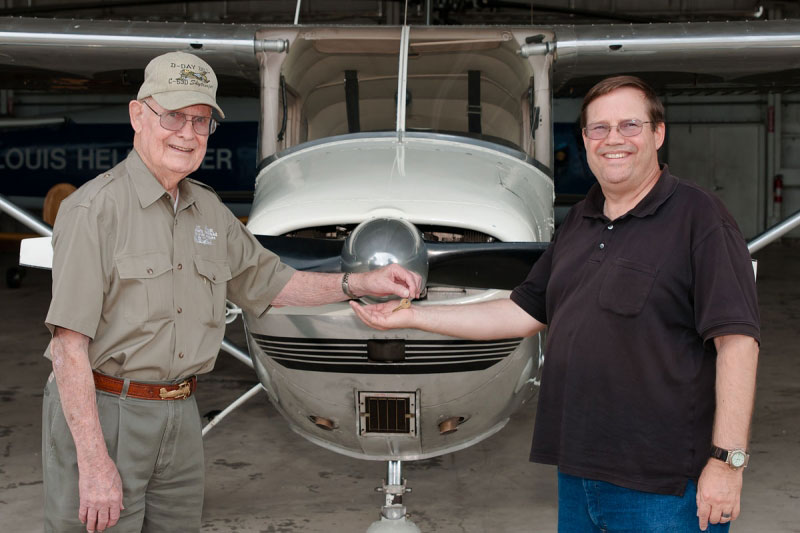
Suspecting that the flight back to Omaha would be hot and bumpy (Texas in August?), I didn’t think it would be wise to bring a nonpilot with me to pick up the plane. Unfortunately, nobody else in the Offutt Aero Club had a good reason the go to Houston or, more to the point, fly back from there with me. I was going to have to go solo.
The “Wings and Wheels” open house was well worth the trip. I spent the day checking out vintage airplanes and vintage cars and touring the museum. The last is still under restoration and, like most museums, items for future exhibits are stored behind the scenes, waiting for their turn in the limelight. It was clearly growing and evolving, supported by a foundation composed of dedicated volunteers.
Preparing for the Flight Home
My original plan for the flight back was an almost straight line from Houston to Offutt with refueling stops at Paris, Texas, and Coffeyville, Kansas, all in one day. However, I was persuaded to take a jog over to Baytown to fill up because the FBO there, for whatever reason, was selling gas for a dollar a gallon cheaper than anywhere else. And how could I find Baytown?
“Head east, watch out for the San Jacinto Monument and bear right of it. It’s only twenty miles, can’t miss it.”
I hate it when people tell me “can’t miss it.” I most certainly can. That wasn’t the most immediate problem, though. I was more worried about Houston Hobby being smack in the middle of its own Class B airspace.
Much of my flying has been in and around Class C airspace, but I find Class B daunting. This was an issue because there was no way to get the airplane out without flying through Class B, short of taxing the twenty-five miles by highway to Baytown before taking off. Since I suspected the Texas Highway Patrol would take a dim view of this option, the only other way was to suck it up and fly out.
Fortunately, the staff were very helpful, assuring me that Houston Hobby was probably the most GA-friendly Class B around and walking me through the radio calls. I wrote the latter down (with frequencies) on small squares of paper and clipped them to my kneeboard in the order they would need to be made. My plan was to read each one in turn then place it neatly on the bottom of the stack. With my radio calls scripted and rehearsed, I felt much more confident.
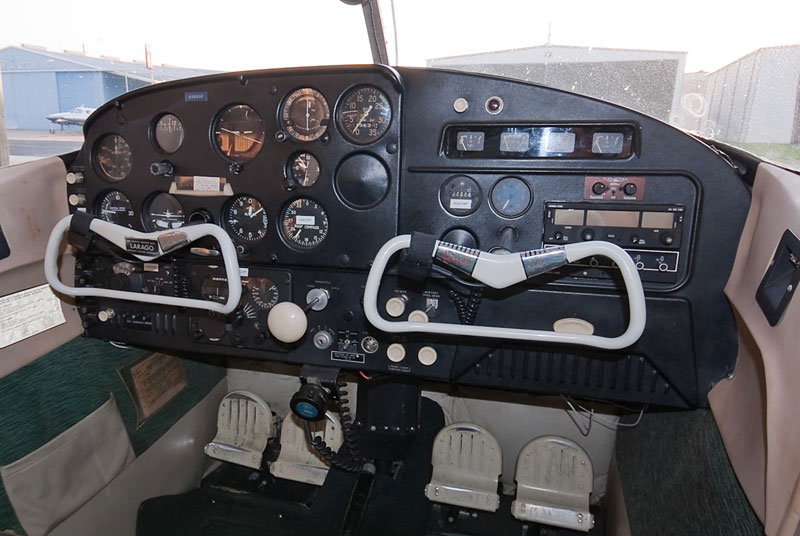
The afternoon before I was to depart we decided to do a familiarization flight over to Baytown, partly to practice my Class B procedures and get a solid idea of just where Baytown was, but mostly to acquaint me with the airplane’s 1958 features. Yes, it was a Cessna 172 and I was checked out in 172’s, but there were some differences between it and the newer models I was used to flying. One immediate difference was the starter; instead of turning the key to start the engine, I turned it to “Both” on the magnetos and pulled a separate handle tucked away beneath the yoke. This is blocked when the control lock is installed, preventing you from starting the engine – let alone attempting to take off – with the control lock in place: good feature. The engine started just fine but showed a 200+ drop on one of the mags. Nope, not flying, even for a short local hop. Since a volunteer mechanic would be available in the morning, we decided to let him take a look and see what could be done.
The next morning the mechanic theorized that the lower spark plugs may have become fouled by oil since the airplane had been sitting on the ramp for a few weeks and that pulling and cleaning them should do the trick. I performed my preflight around him while he worked, and when he was done, we cranked the engine. The mags checked! We buttoned up the cowling, shook hands all around, and I loaded up to depart.
Struck by Lightning on Approach to Dallas
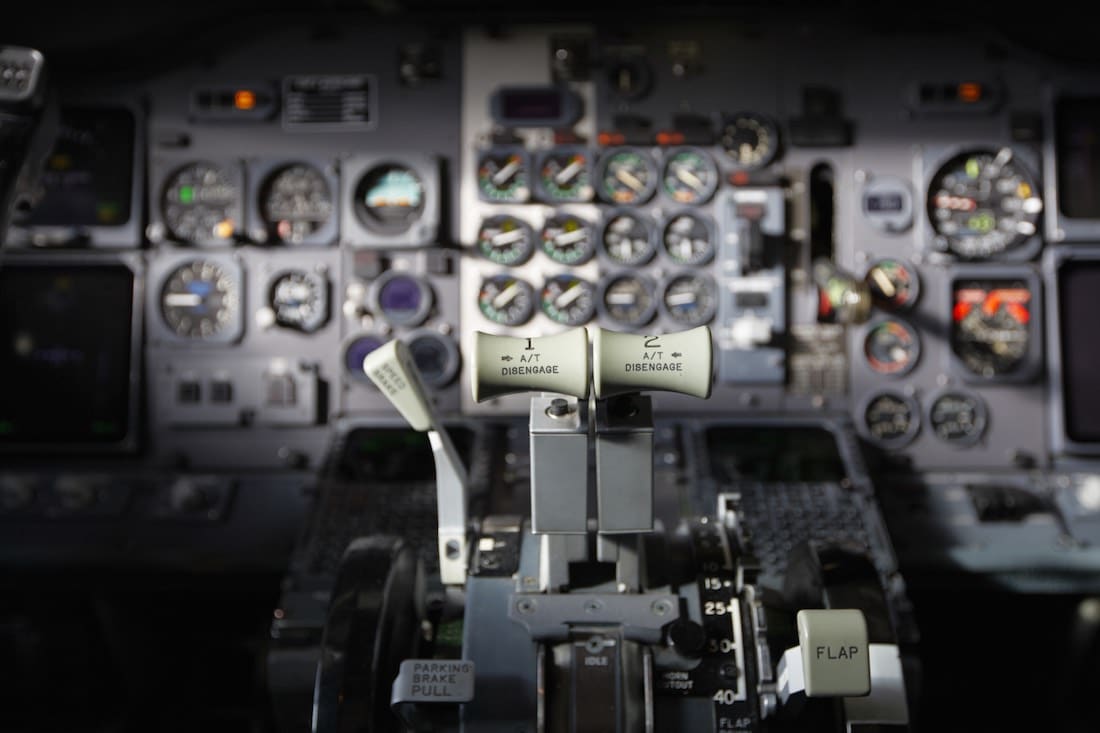 Even though pilots train constantly for specific nonstandard situations, emergencies never abide by an exact scenario. In the real world, there are always infinite variables which can’t be duplicated in a simulator. The core of pilot training is about learning how to handle the variables so when the unexpected happens, your brain can still put the pieces together even though you can’t see the whole puzzle. My crew and I had to quickly put together a doozy of a puzzle during one of my first captain’s flights in the Boeing 727-200 after we were struck by lightning, on approach, in a snowstorm, in Dallas, on New Year’s Eve [Click to read more…]
Even though pilots train constantly for specific nonstandard situations, emergencies never abide by an exact scenario. In the real world, there are always infinite variables which can’t be duplicated in a simulator. The core of pilot training is about learning how to handle the variables so when the unexpected happens, your brain can still put the pieces together even though you can’t see the whole puzzle. My crew and I had to quickly put together a doozy of a puzzle during one of my first captain’s flights in the Boeing 727-200 after we were struck by lightning, on approach, in a snowstorm, in Dallas, on New Year’s Eve [Click to read more…]
On the Road Again…
It was all going great until I keyed the mike for my first radio call.
Nothing.
I wiggled the push-to-talk button. Nope. I turned the radio off and back on and tried again.
Again, nothing. Oh, bad words.
I looked up. The small crowd of well-wishers who had gathered to cheer my departure were watching me, obviously perplexed by the delay.
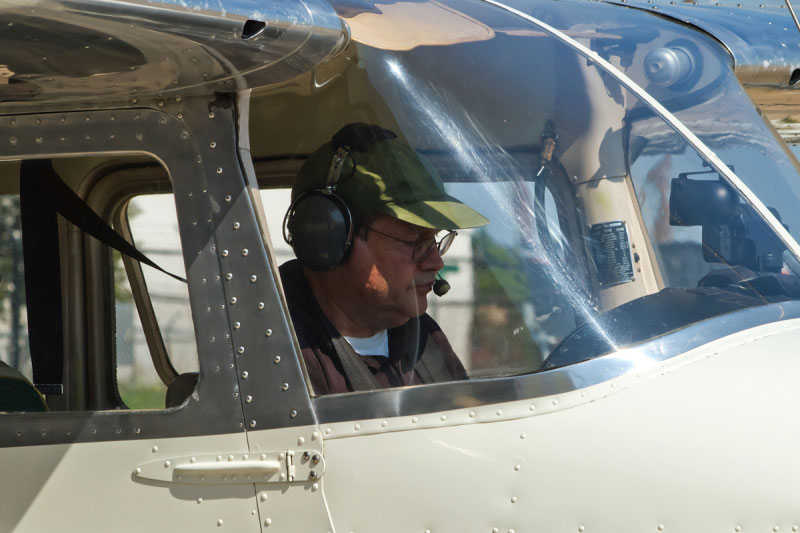
OK, that’s why there’s a backup. I pushed the boom microphone out of the way, grabbed the handheld microphone and made the call.
Success! I smiled and waved at everybody and taxied out, clipping the microphone back into its holder. The tower kept me on the hold until a Southwest 737 that had just taken off on an adjacent runway was well on its way, then cleared me for takeoff.
There’s always been something magical to me about takeoff, especially that moment when the airplane stops rolling and starts flying. On this day that was particularly special; it was my first takeoff in my very own airplane. As the ground dropped away I wanted to laugh for pure joy.
Meanwhile, back in reality. . . .
Even GA-friendly Class B is still Class B, the “B” standing for “Busy,” as John King says in his videos. When the controllers talk to you in Class B airspace, they want to hear back now, not in a little while once you’ve gotten your emotions under control, found the right little piece of paper, unclipped your handheld microphone, and started reading your response. Also, once you’ve finished with that little piece of paper it takes, oddly enough, two hands to remove it from the top of the stack and neatly tuck it away on the bottom. Meanwhile, of course, you need hands for other things, such as flying the airplane, refolding your sectional and changing frequencies on the radio.
You can probably see where this going. By the time I was clear of Houston Hobby’s inner ring the microphone was in my lap and the cockpit was littered with little pieces of paper (some of which I didn’t find again until the next annual). With a functioning push-to-talk switch my little plan might have worked, but without it I needed at least three hands to do all the aviating, navigating and communicating necessary.
That was one challenge surmounted and lesson learned, now on to Baytown! Head east, bear right of the San Jacinto Monument . . . it occurred to me at this point that the monument would probably be easier to find if I had some idea of what it looked like. In lieu of our familiarization flight, I had meant to look it up on the internet but had forgotten.
Well, there was this monument-looking thingy approximately where it should be, based on the chart’s simple notation of “monument.” Must not be too many monuments out here, I thought. I adjusted course to pass right of it and voila, an airport! Departure cleared me VFR, commenting that there didn’t seem to be any other traffic in the pattern, which brought me up short. Cheap gas and nobody was coming to take advantage of it but me? I couldn’t hear anybody else on CTAF, either. Was this really the right airport?
I entered the pattern on left downwind, my head on a swivel. Maybe others were there, just not squawking or talking. It was eerily quiet as I landed, taxied up to the pumps, and shut down.
That changed.
I topped off my right tank and, by the time I had moved over to the left, the pattern was full of airplanes, most of which started lining up behind me after they landed. What was disturbing about it was that the guy right behind me kept the fan going while they waited. Yes, they were obviously here for the cheap gas, but it wasn’t that cheap. I hurriedly finished gassing up, hooked up my towbar and dragged the airplane off to a spot near the FBO office. As I was going into the office a guy standing next to the door said “Boy, what did you do? I’ve never seen so many airplanes at this airport!”
I got a weather update, filed for the leg to Paris and picked up a spare quart of oil. As I took off out of Baytown, airplanes were still arriving. Why the rush started with me I have no idea to this day.
Baytown to Paris
Departing Baytown to the north I settled down to cruise at 4500 feet. It was a beautiful, cloudless morning, cool and smooth, not what I had expected for this trip. Paris, Texas, here we come!
On second thought, maybe it wasn’t quite cloudless. I noticed a thin line ahead of me, flat on the bottom and lumpy above. It was clouds, which appeared to be at my altitude. They weren’t storm clouds, but they seemed to be forming an overcast. My first thought was to climb above them – if it was cool and smooth at 4500, surely it would be cooler and smoother at 6500 – but if it really was an overcast that entailed the risk of being caught on top. Well, maybe they weren’t at my altitude.
Nope, as I got closer it became clear that if I continued at this altitude I would fly right into them. Reluctantly I dropped below them. As expected, it was hot and bumpy down there. I bumped and ground along for awhile, sweating and casting despairing glances upward from time to time. Well, wait a minute, maybe it wasn’t an overcast. There were huge gaps between the clouds. Looking at them from the same altitude the clouds looked like a sold line of puffies, but from below they just looked like clouds scattered across the sky.
Being thrown upward against the harness several times in quick succession decided the issue for me. I added power and climbed up to 6500 feet.
Mountain Wave: My Scariest Flight Ever
 … We approached the eastern edge of the mountains, where the terrain drops almost straight down to the Owens Valley. This is one of the steepest and deepest drop-offs in the continental U.S. Just as we approached the edge the GPS showed our groundspeed increase rapidly from 175 to 228 knots. A moment later the plane crossed the ridge and suddenly everything went wild. The first smack knocked our headphones off and our heads into the ceiling despite seat belts [Click to read more…]
… We approached the eastern edge of the mountains, where the terrain drops almost straight down to the Owens Valley. This is one of the steepest and deepest drop-offs in the continental U.S. Just as we approached the edge the GPS showed our groundspeed increase rapidly from 175 to 228 knots. A moment later the plane crossed the ridge and suddenly everything went wild. The first smack knocked our headphones off and our heads into the ceiling despite seat belts [Click to read more…]
Ah, cool, smooth bliss. But alas, it was not to last. Clouds started growing up to, and through, my altitude, forcing me to maneuver around them. Ok, up to 8500, then? A glance down showed that, although I could still see the ground, the clouds appeared to be getting closer together. Once again the prospect of getting caught on top reared its ugly head.
Sweating and bumping along back at 3000 feet I congratulated myself on making the prudent choice, accepting discomfort as the price for safety. My instructor would have been proud. However, I couldn’t help thinking, more than a little spitefully, that it was only too bad he wasn’t there to share in my triumph.
A Short Break in Paris, Texas, and a View
By the time I reached Paris I was feeling thoroughly beaten up. The plan had been to gas up, eat a quick lunch, get a weather update, file for the next leg and take off again as quickly as possible, but it didn’t work out that way. Lunch alone took as long as the entire stop had been planned for (note: Paris has some of the nicest airport loaner vehicles I have ever seen). Then I made the mistake of sitting down on this incredibly comfy couch in the cool, air-conditioned pilot’s lounge, closing my eyes for just a minute . . . and waking up an hour later.
Because of these delays, my departure from Paris was much later in the afternoon than originally scheduled. However, this turned out to be not such a bad thing. With the sun lower in the sky the thermals started dying down, and north of Paris, the clouds thinned out to almost nothing. I cruised along at 4500 feet, high enough for the air to be cool and relatively smooth, low enough to enjoy the view. And there was a view.
In southern Oklahoma I crossed the tag end of the Ozarks, the Ouachita Mountains, They seemed almost incongruous after hundreds of miles of plains but hey, there they were, greenly wooded ridges rising 2000 feet with deep valleys between them. I lived for many years in the foothills of the Smoky Mountains, and these reminded me of them. I marked several places on my chart that I’d like to return to someday.
Coffeyville and the Chief
The flight across Oklahoma was so pleasant that when I reached Coffeyville, Kansas, I felt better and more refreshed than when I had taken off from Paris. I landed and taxied in, parking next to the only other airplane on the ramp, a cute little yellow Aeronca Chief. The FBO office was manned by only one person, who turned out to be the manager, lineboy, auto rental agent and who-knows-what-else. I asked him about the Chief.
“Guy flew it up from Texas. He parked it here, said he was tired of getting beat up by the thermals and that he was going to continue his travels by other means.”
On the wall of the office was a framed photo of a MiG-17 with a scrawled autograph. I recognized the airplane as one that performed regularly at Offutt airshows. As a “Warbird Support” volunteer during one of the shows, I had helped the pilot clean the MiG’s canopy.
“Is that Randy Ball’s MiG?”
“Yup, this is his favorite refueling stop.”
I had hoped to make the trip in one day but, with the delays, realized there was no way I could get all the way to Offutt before dark. Unfortunately, I was non-current in night landings. The friendly jack-of-all-trades rented me a car and recommended a hotel.
The Last Leg Home
The next morning at breakfast I overheard some guys talking about enroute weather and terminal forecasts. They weren’t dressed like airline pilots and the only transient private airplane I knew about was the Chief. They left the hotel before I did and, sure enough, by the time I arrived at the airport the Chief was gone. It turned out the owner had engaged them to pick up his airplane.
With that fresh reminder of how unpleasant flying through the middle of the day could be, I took off from Coffeyville and braced myself for the coming ordeal. To pre-empt as much of it as possible I climbed up to 6500 feet, hoping I’d be able to stay there for at least part of the trip.
Surprise! No cloud decks formed at inconvenient altitudes, no wayward thermals intruded themselves except as stray bumps now and then. I cruised across Kansas, gradually beginning to realize this was going to be easier than the day before. Along the way I passed by the Topeka Regional Airport, formerly Forbes AFB and then – home to the 55th Strategic Reconnaissance Wing, the latter now styled the 55th Wing and based at Offutt. With its enormous runways, Topeka Regional certainly looked like an old Strategic Air Command base.
Shortly afterward, off in the distance, I noticed another airport. It had a familiar configuration, a concrete main runway crossed by a shorter grass one, but for the life of me, on my sectional, I couldn’t locate any such airfield in Kansas along my route of flight. Funny, it looked just like the airport at . . . Nebraska City!
I was home! Well, almost home. Nebraska City was farther away than it looked, but it wasn’t long before I had passed it and had to descend. I dropped down to 2500 feet before reaching Plattsmouth and called Omaha Approach. By the way, as I descended through 3000 feet it suddenly became warm and bumpy, but by then it didn’t matter.

Final Thoughts
On the ground at Offutt, I tucked my little airplane away in the hangar and collected my bags. Stepping back and looking at it, I marveled that this was my airplane. That didn’t seem quite real. Were the last few days a dream, and any moment I’d wake up?
We’ve had adventures since then, my “$50 airplane” and I, and I hope we have many more, but that flight back from Houston has been, so far, my most memorable flight. And to think, it all started from stumbling over a fundraiser for an old building that looked – to me at least – like something out of Oz.
Featured Image: Eight-Five Fox and the Author, courtesy of Blair McFarlain of the 1940 Air Terminal Museum.
How I Fell in Love With Aviation Before My Discovery Flight

For many pilots, the first flying lesson, “The Discovery Flight,” is the day that they fall in love with aviation. I’ve always prided myself in being a little different, and flying was no exception. For me, the day I fell in love with flying was years before I ever took my first lesson.
When I was 10 years old, my mom jokingly asked for flying lessons for my parent’s wedding anniversary. My dad listened to my mom’s request and bought her gift certificates for two flying lessons at the local airport [Click to read more…]






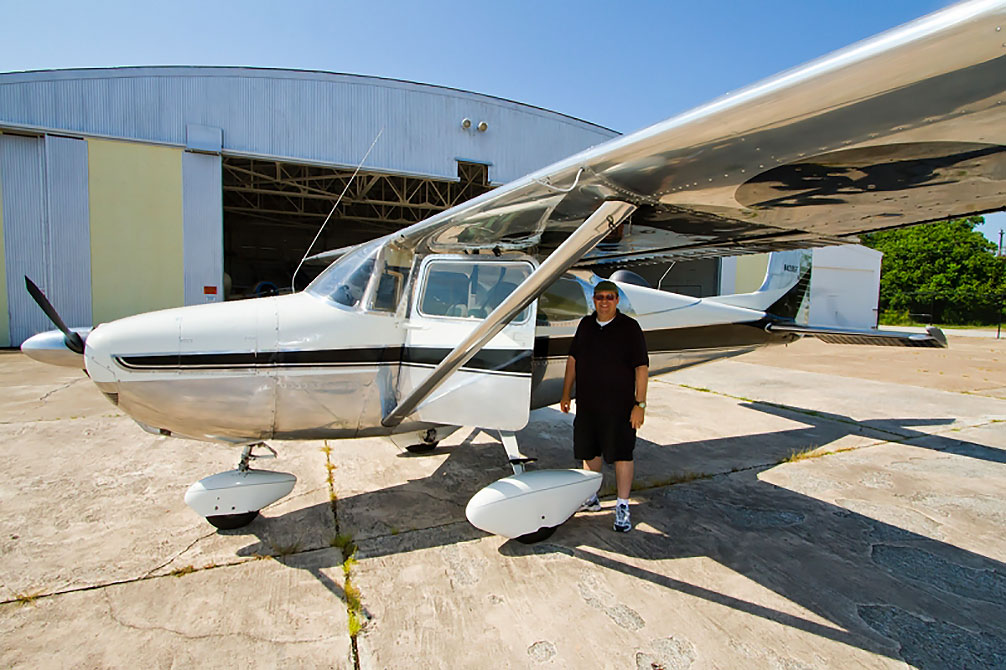






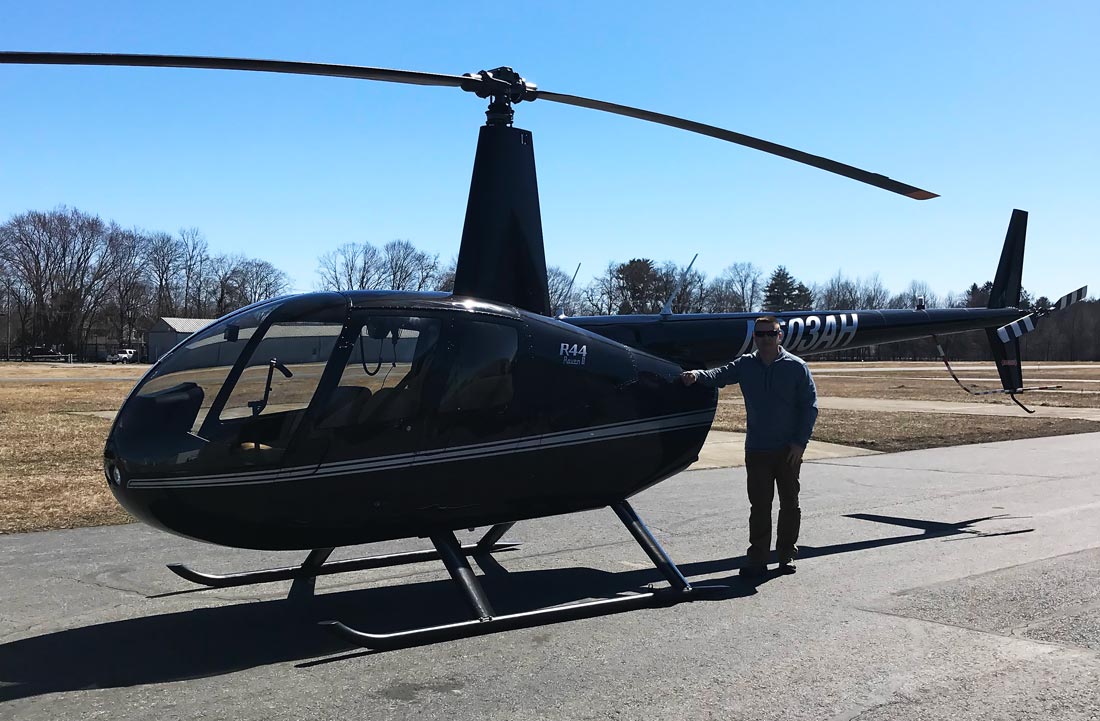

What a fantastic write-up! I am a former volunteer at The 1940 Air Terminal Museum and one of the things I had the opportunity to do was fly the raffle planes to various events to sell tickets. I had the privilege of flying three of the different raffle planes, and despite only being able to put eight-five-fox in my logbook once, it was my favorite of the bunch. She just flew so smoothly it was like a dream!
Here’s a video of my landing: //youtu.be/k8glNIj41AM